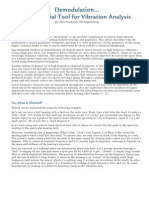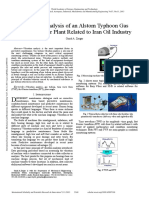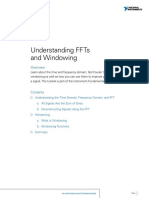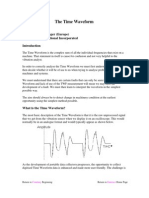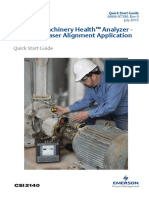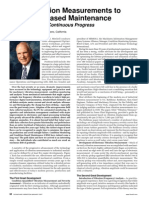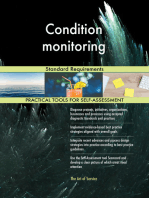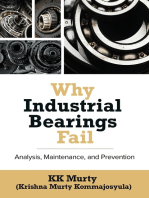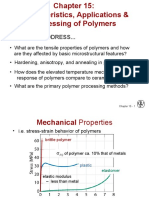IRTLevel1 3TrainingBrochure
IRTLevel1 3TrainingBrochure
Uploaded by
gedearthanaCopyright:
Available Formats
IRTLevel1 3TrainingBrochure
IRTLevel1 3TrainingBrochure
Uploaded by
gedearthanaOriginal Title
Copyright
Available Formats
Share this document
Did you find this document useful?
Is this content inappropriate?
Copyright:
Available Formats
IRTLevel1 3TrainingBrochure
IRTLevel1 3TrainingBrochure
Uploaded by
gedearthanaCopyright:
Available Formats
Infrared Thermography
CAT1A, Level 1-3
Advance your skills and knowledge in the field of infrared
thermography
Infrared Thermography Category 1A
Learn the 7 IRT CAT 1A, The 7 Measurement Rules©, is the best introduction for any beginner
Measurement Rules© of Infrared Thermographer. For instance have you ever noticed that temperatures
displayed by an infrared camera are sometimes obviously wrong? Do you understand
Infrared Thermography. the difference between radiation and temperature? That IR cameras measure radiation
and calculates temperature? Based on a number of variables controlled by the
thermographer? This course will teach you the basics of Infrared Thermography, giving
delegates a good theoretical and practical foundation to kick-start their understanding
and application of Infrared Thermography.
Course Detail
Tailored for the newcomer to the world of Thermography; the course focuses on the
seven basic rules to be followed when using a thermal camera in practice to measure
temperature accurately enough to base sound engineering decisions on the results.
On the first day, you’ll learn the essentials of using a thermal camera effectively. Day
two focuses on using the camera practically, taking images of real life equipment
measurement and including the creation of a thermal report from the images taken
with your own camera using the supplied software.
Who Should Attend This Course?
• First time Infrared Thermography Camera owners
• Basic training before attending Infrared Thermography Level 1 course
Course Benefits
This course accelerates the user’s ability to use the thermal camera and the software for
the purpose it was bought for - quickly and without fuss. It will enable you to put an
expensive instrument to immediate good use, minimising the start-up time to produce
the first thermal report correctly and with confidence.
Infrared Thermography Level 1-3 | 2
7 Measurement Rules©
Course Outline
Bring your camera Day One (Theory) 5. Reflected Apparent Temperature –
Understand that everything always
and your laptop and
Introduction to the peculiarities and reflects something and that your
our experienced applications of infrared thermography. target is mostly a mirror! Learn the
thermographers will importance of Trefl and how to
get you, your camera 1. Focus - Learn the “How To” of a estimate it correctly.
thermal camera, and understand
and your software up 6. Emissivity – Learn the practical
why focussing sounds easier than it
and running in two really is, i.e. realising the difference craft of measuring and estimating
wonderfully interesting between IR and Visual. emissivity and the importance of
getting it right (Plus a few practical
and valuable days. tips for the field).
2. Composition – Understand the
concept of the identification of an
Object of Interest (OOI) and an Area 7. Data Capture – Learn the
of Interest (AOI); as well as collecting practicalities involved with saving
and presenting the thermal data and working with thermal data.
correctly.
The remainder of the afternoon is spent
3. Thermal Contrast – Understand that discussing the interpretation and analysis
cameras are not intelligent and can of field case studies.
only display what it sees, and that
thermographers need to adjust every Day Two (Practical)
image to reveal the real thermal
patterns. 1. Practice the measurement rules by
performing thermal inspections.
4. Environment - Adjusting for, and 2. Produce and prepare a report
understanding the importance of, template in your software.
the influences of the atmosphere on 3. Managing thermal data and
your measurements. producing a thermal report.
Infrared Thermography Level 1-3 | 3
Infrared Thermography Level 1 (ITC)
Become a Level 1 This course prepares you for qualification as a category 1 certified thermographer.
certified thermographer You will learn about the basics of infrared, how to operate the camera under different
conditions and for various purposes, how to do an appropriate judgement of the
and gain a competitive measurement situation in the field and identify potential error sources. You will be
advantage. able to do IR inspections following written guidelines and to report the result of this
inspection.
Course Detail
After a short introduction to thermography you will have hands-on training. The theory
sections on heat and infrared will provide you with the basic knowledge needed to
use the IR camera in the field, and to recognize and interpret thermal patterns. Strong
emphasis will be put on the IR measurement techniques and the influence of emissivity
and reflectivity on the measurement results.
You will train the measurement on real-life lab equipment and you will also learn how
and when to use qualitative and quantitative thermography. A short introduction to
inspection routines and reporting principles will finalize the lecture. Now you will be
well prepared to create a short case study which you will present in front of the class.
The course ends with an exam including multiple choice questions and thermogram
analysis.
The class includes exercises and our trainers work with images, sketches, and simple
diagrams to illustrate the theoretical parts in a descriptive way.
Who Should Attend This Course?
This course is designed for beginners in thermography with some experience in camera
handling and limited IR knowledge, who want to take their first step to become a
professional thermographer and want to qualify as a Level 1 certified thermographer.
Course Benefits
• The ITC is an Accredited Training applications. patterns in thermal images.
Organization in conformance to the • Benefit hugely from an extensive • See and experience the latest
British Institute of Non Destructive overview of practical applications of in infrared inspection report
Testing (BINDT) BS EN ISO Infrared Thermography. generation and database software.
9001:2000 with certificate issued • Collect quality data; make accurate • Avoid costly mistakes - learn to
25 May 2006. temperature measurements using distinguish between hot spots
• The ITC Infrared Thermography the infrared camera, and account and reflections, direct vs. indirect
Level 1 Course is validated against for external influencing effects such readings and qualitative vs.
the BINDT requirements for the as atmospheric conditions; (ambient quantitative thermography.
structured training of Condition temperature, distance & humidity) • Challenge yourself with field
Monitoring practitioners. as well as Reflected Apparent applications labs that closely
• Learn the basics of infrared camera Temperature and Emissivity using simulate real-world infrared
care and handling. infrared cameras. applications.
• Introduction to thermal imaging • Interpret thermograms and make • Learn the practical pitfalls and
and measurement systems informed decisions using heat receive tips for performing thermal
for predictive maintenance transfer concepts to analyse thermal inspections in the plant.
Infrared Thermography Level 1-3 | 4
Infrared Thermography Level 1
Course Outline
No prior certification or 1. Introduction to Thermography: • Real life targets
• Introduction to infrared
experience is necessary
thermography 7. Thermal Image Interpretation
to attend this course, • Why is temperature important? • Camera principle
although ownership • Applications • Visual versus infrared
of an infrared camera, • The thermal image
2. IR Camera introduction: • Apparent temperature and
laptop and software • Controlling the image emissivity
would be beneficial • Measurement functions
(bring along if possible). • Capturing an image 8. Thermal Image Analysis Techniques
• The “Big Three” • Thermal gradient
• Temperature range • Camera tools for pattern
Typically the mornings • Optical focusing enhancement
are spent on theory • Image composition • Thermal tuning
lectures and the • Storage devices • Image analysis – misleading
• Practical tips patterns
afternoons on practical
exercises with cameras 3. Basic Thermal Science: 9. Qualitative and Quantitative
and props. • Heat and temperature • Qualitative
• Units for measuring temperature • Quantitative
• Rules in thermal science • Fault classification criteria
• Baseline data
4. Basic Heat Transfer
• Heat transfer modes 10. Infrared Measurement Techniques
• Conduction • Radiated energy and temperature
• Convection • Calibration
• Radiation heat transfer • Compensation for effects of the
surroundings
5. The Electromagnetic Spectrum • Measurement conditions
• Waves
• The electromagnetic spectrum 11. Infrared Measurement Techniques
• Radiated energy and temperature
6. Radiation Energy Exchange • Calibration
• Radiation energy exchange • Compensation for effects of the
modes surroundings
• Incident radiation • Measurement conditions
• Exitant radiation
• Blackbodies 12. Thermography Guidelines
Infrared Thermography Level 1-3 | 5
Infrared Thermography Level 2 (ITC)
Become a Level 2 This course prepares you for qualification as a category 2 certified thermographer. You
certified thermographer will learn about topics in infrared thermography to both deepen and broaden your
knowledge about infrared physics, heat science, infrared measurement equipment and
and increase your IR its application. As a Level 2 thermographer you shall provide guidance to category 1
knowledge. personnel in the areas of equipment selection, techniques, limitations, data analysis,
corrective actions and reporting.
Course Detail
After a short introduction to certification levels and procedures, and related standards,
you will take an initial test. During the course you will repeat and learn more about
thermal science and heat transfer as well as gain advanced knowledge on IR theory
and IR equipment. The course ends with a multiple choice exam.
The course includes advanced practical exercises and discussions about the participants’
professional experiences and cases from the field. Thermal and infrared science theory
are taught by using formulas, diagrams, and graphs. The focus is on steady-state
processes, but transient mechanisms are also included.
Who Should Attend This Course?
This course is designed for thermographers holding a Level 1 certificate, who want
to increase their knowledge about IR thermography and want to qualify as a Level 2
certified thermographer.
In order to attend a Level 2 Thermography Course
• You will hold a valid Level 1 thermography certificate,
• You will have the recommended experience within thermography according to
relevant standards,
• You will prepare a case study to be presented at the Level 2 course and submitted
towards qualification at course closing.
Course Benefits
• Reinforce Level I infrared training Excel-based application software standards, and the ASNT SNT-TC-1A
concepts with refresher material (included). Level II standard.
covering the latest infrared camera, • Refine your image analysis and • The course not only prepares
technology and thermal imaging interpretation proficiency with the thermographer to carry out
application developments. in-depth thermal imaging survey advanced thermal analyses and
• Expand your thermography and measurement techniques for compile professional reports, it
knowledge with new, more in-depth predictive maintenance applications. is also structured to prepare the
concepts in infrared theory, heat • Learn to measure emissivity of delegate for the final examination on
transfer and spatial resolution. common materials. day five.
• Learn the basics of predictive • Improve your thermal analysis skills • The course is vendor neutral and
maintenance thermography and with more challenging laboratory delegates are encouraged to attend
overall infrared inspection program and infrared field applications labs. with any thermal camera.
development. • The training course and exam
• Learn to calculate avoided costs with follows the ISO 18436-7 Category 2
Infrared Thermography Level 1-3 | 6
Infrared Thermography Level 2
Course Outline
Bring: Certified copy 1. Principles of infrared thermography: thermal severity assessment
• Fourier’s Law, Newton’s Law of criteria
of valid Level 1 IRT
Cooling
Certificate, Scientific • Atmospheric transmission, 4. General applications
calculator, Thermal Radiation reference sources
camera, laptop and • Planck’s Law, Wien’s Law, 5. Diagnostics and prognostics
Emissivity, and factors affecting
software, Practical emissivity 6. Condition monitoring applications:
field assignment for • Machinery engineering principles
presentation on day 2. Equipment and data acquisition: (components and construction)
one. • Infrared camera selection • Typical machinery failure modes
criteria, Spectral bands, Thermal and mechanisms and their
sensitivity (NETD), Lens selection, associated thermal signatures
Optical resolution, and Operation • Severity assessment and
of equipment acceptance criteria (engineering
• Image composition, Emissivity codes and standards)
determination, Error source
recognition, prevention or 7. Corrective actions
control, Waveband selection
criteria 8. Reporting and documentation (ISO
• Recognizing and dealing with International Standards)
radiation, convection, and
conduction 9. Condition monitoring programme
• Effects of incorrect emissivity, design
Camera calibration and • General principles, Technique
Environmental and operational selection, Measurement intervals
conditions • Reference temperatures, and
Baseline temperatures
3. Image processing: • Procedure development
• Temperature measurement, and
Comparative quantitative and 10. Condition monitoring programme
qualitative thermography implementation
• Camera measurement tools,
Measurement tools, Distance 11. Condition monitoring programme
(atmospheric) correction, management
Emissivity correction • Safety, Equipment and Procedure
• Statistical analysis , Image management
subtraction, Image montage and • Skills and competencies
Temperature trending management
• General image interpretation • Database management
guidelines, and General • Managing corrective action
guidelines for establishing implementation
Infrared Thermography Level 1-3 | 7
Infrared Thermography Level 3
Become a Level 3 This course assumes the attending delegate to be an advanced, experienced user
certified thermographer of thermal cameras, already familiar with all theoretical and practical aspects of the
technology as taught in Levels 1 and 2. The delegate should preferably have in excess
with advanced IR skills of two years practical IRT experience.
and knowledge.
Course Benefits
• The training course and exam delegates), and then take these kits
follows the ISO 18436-7 Category 3 back to their workplace and show
standard, and the ASNT SNT-TC-1A off their newly acquired skills.
Level III standard. • The course not only prepares
• The course is unique in that it the thermographer to carry out
combines practical workshop advanced thermal analyses and
sessions with the relevant theory compile professional reports, it
required by ISO 18436-7. The is also structured to prepare the
level 3 demonstration kits that are delegate for the final examination on
included in the price of the course, day five.
allow delegates to conduct their • The course is vendor neutral and
own practical workshop exercises delegates are encouraged to attend
(without having to share with other with any thermal camera.
Infrared Thermography Level 1-3 | 8
Infrared Thermography Level 3
Course Outline
Please bring along: The contents of this course closely follow • General image interpretation
the requirements of ISO 18436-7 and guidelines, and General
Valid Level 2 Certificate,
contain as minimum the following: guidelines for establishing
Thermal camera, Laptop thermal severity assessment
with installed reporting 1. Principles of infrared thermography criteria
and analysis software, (IRT) :
• Fourier’s Law, Newton’s Law of 4. General applications
scientific calculator, Cooling
open mind… • Atmospheric transmission, 5. Diagnostics and prognostics
Radiation reference sources
• Planck’s Law, Wien’s Law, 6. Condition monitoring applications:
Stephan-Bolzmann Law, • Machinery engineering principles
Emissivity and its influencing (components and construction)
factors. • Typical machinery failure modes
and mechanisms and their
2. Equipment and data acquisition: associated thermal signatures
• Infrared camera selection • Severity assessment and
criteria, Spectral bands, Thermal acceptance criteria (engineering
sensitivity (NETD), Lens selection, codes and standards)
Optical resolution, and Equipment
Operation. 7. Corrective actions
• Image composition, Emissivity
determination, Error source 8. Reporting and documentation (ISO
recognition, prevention and International Standards)
control, Wavelength selection
criteria. 9. Condition monitoring programme
• Recognizing and dealing with design:
radiation, convection, and • General principles, Technique
conduction. selection, Measurement intervals
• Effects of incorrect emissivity • Reference temperatures, and
settings, Camera calibration and Baseline temperatures
Environmental and operational • Procedure development
conditions.
10. Condition monitoring programme
3. Image processing: implementation
• Temperature measurement,
Comparative quantitative 11. Condition monitoring programme
and qualitative thermography management:
techniques. • Safety, Equipment and Procedure
• Camera measurement tools, management
Advanced Software Measurement • Skills and competencies
tools, Distance (atmospheric) management
correction, Emissivity correction • Database management
• Statistical analysis , Image • Managing corrective action
subtraction, Image montage and implementation
Temperature trending
Infrared Thermography Level 1-3 | 9
Training Opportunities
Yellotec offers a full Private Courses
complement of training
All our public training courses can also be conducted as an in-house private courses.
courses in Condition If you have 12 or more people attending, consider the benefits of an in-house session
Monitoring disciplines conducted in the privacy and conveniences of your facilities or a meeting site of your
as well product and choice. Please contact us so that we can understand your requirements, explore the
benefits and make it happen.
Reliability Engineering
specific courses. Courses
offered are either All Courses Offered By Yellotec
presented under license Infrared Thermography (IRT) Shaft Alignment
from International IRT Basics, Level 1, Level 2 and Level 3 Level 1
Certification Bodies or
Vibration Analysis (Mobius) Ultrasound
are in accordance with Level 1 and 2
Category 1, 2 and 3
ISO requirements.
Field Lubricant Analysis Gearbox Maintenance
Noria Level 1, 2 and 3
Failure Analysis
Machinery Lubrication
Condition Monitoring for Engineers
Noria Level 1 and 2
Plant Management – Dr. Mike Vorster
Oil Analysis Series
Level 1, 2 and 3
Infrared Thermography Level 1-3 | 10
Registration Form
Please register each delegate by completing the details below and return by fax to 011 656 9112, or
e-mail to training@yellotec.com. The company details are intended for accounting purposes and must
reflect the details required for the completion and delivery of tax invoice.
Invoice Details Company
VAT Number
Postal Address
Postal Code
Person Responsible for Payment
Contact Number
E-Mail Address
Fax Number
Payment Method Purchase Order Number
Cheque Number
Electronic Transfer Ref Number
Delegate Details Delegate Name
Contact Number
Fax Number
E-mail Address
Do you have Halaal requirements? Yes No
Course Details Course
Dates
Cost (Excl. VAT)
Terms and Conditions
1. All course fees are payable upon confirmation of booking and an invoice will be sent as per the details indicated
above. Bookings cannot be secured until payment of invoice or valid purchase order is received.
2. Only cancellations received in writing 10 days before the start of the course will be refunded in full.
3. There will be no charge if a substitute person wishes to replace the original delegate.
4. Yellotec reserves the right to cancel any course at any time without liability. In these circumstances, delegates will
be offered an alternative date, or a full refund.
5. All Halaal requirements will be charged at an extra cost.
6. Delegate no shows, partial attendance or late cancellations will be liable for full cost.
Infrared Thermography Level 1-3 | 11
Co. Name: Yellow Technical Services (Pty) Ltd.
Trading as: Yellotec
www.yellotec.com PO Box 31448 33 Taljaard Road Reg. No: 2013/231556/07
[t] +27 (0) 11 656 9111 Kyalami Bartlett VAT No.: 4020210219
[f] +27 (0) 11 656 9112 1685 Boksburg
training@yellotec.com
Yellotec is a products, service and training provider in the
following specialist fields:
1. Complete solutions for the implementation and 6. Thermographic Analysis Services.
management of Condition Based Maintenance. 7. Laser Alignment & Balancing Services.
2. Remote Diagnosis of Vibration Analysis. 8. Training in all specialist areas of Condition Based
3. Full on-site CBM services, ranging from single Maintenance
individuals to complete department. 9. Direct agents for Flir Systems (Sweden) and
4. Oil Analysis Laboratory Services. Prüftechnik(Germany).
5. Vibration Analysis Services.
PUB-10-0027-04-IRT Level 1-3
You might also like
- Chemical Reaction Engineering: Third EditionDocument684 pagesChemical Reaction Engineering: Third Editionharsh mohaneNo ratings yet
- SAMURAI - Manual en 3.0 NewDocument148 pagesSAMURAI - Manual en 3.0 NewRenzo ArangoNo ratings yet
- Vibration Basics and Machine Reliability Simplified : A Practical Guide to Vibration AnalysisFrom EverandVibration Basics and Machine Reliability Simplified : A Practical Guide to Vibration AnalysisRating: 4 out of 5 stars4/5 (2)
- Fluid Mechanics Concept & Centrifugal Pump DesignDocument84 pagesFluid Mechanics Concept & Centrifugal Pump DesignRIMEL ASMANo ratings yet
- Demodulation... An Essential Tool For Vibration AnalysisDocument3 pagesDemodulation... An Essential Tool For Vibration AnalysisSsener SSenerNo ratings yet
- Vibration-based Condition Monitoring: Industrial, Aerospace and Automotive ApplicationsFrom EverandVibration-based Condition Monitoring: Industrial, Aerospace and Automotive ApplicationsNo ratings yet
- Pitfalls in The Analysis of Machinery Vibration MeasurementsDocument7 pagesPitfalls in The Analysis of Machinery Vibration MeasurementsTheerayoot PoomchaiNo ratings yet
- PDM in Action-eBookDocument24 pagesPDM in Action-eBookFELIX VALERA100% (1)
- C E R M: Ertification XAM Eference AterialDocument10 pagesC E R M: Ertification XAM Eference AterialMarco AntonioNo ratings yet
- Using PeakVue Plus Technology For Detecting Anti Friction Bearing FaultsDocument11 pagesUsing PeakVue Plus Technology For Detecting Anti Friction Bearing Faultseko bagus sunaryo100% (1)
- Machinery Fault DiagnosisDocument45 pagesMachinery Fault DiagnosisAhmed El TayebNo ratings yet
- CM3152 en SKF Idler Sound MonitorDocument4 pagesCM3152 en SKF Idler Sound MonitorLuisSilvaNo ratings yet
- Vibration Analysis of An Alstom Typhoon Gas Turbine Power Plant Related To Iran Oil IndustryDocument8 pagesVibration Analysis of An Alstom Typhoon Gas Turbine Power Plant Related To Iran Oil IndustryFajar HidayatNo ratings yet
- Presentacion IlearnDocument38 pagesPresentacion IlearnAnonymous ffje1rpaNo ratings yet
- Raw Mill Drive Line IIDocument5 pagesRaw Mill Drive Line IIHosam Abd ElkhalekNo ratings yet
- Low Frequency EvaluationDocument13 pagesLow Frequency EvaluationthrillerxNo ratings yet
- CM3146 en FRF Testing-How Select Correct HammerDocument8 pagesCM3146 en FRF Testing-How Select Correct HammerLuisSilvaNo ratings yet
- Order Analysis ToolkitDocument16 pagesOrder Analysis ToolkitManuel Enrique Salas FernándezNo ratings yet
- Understanding FFTs and WindowingDocument15 pagesUnderstanding FFTs and WindowingSamruddha ThakurNo ratings yet
- Vibration Analysis of Ball Bearings: A Seminar OnDocument22 pagesVibration Analysis of Ball Bearings: A Seminar OnArun ThomasNo ratings yet
- Rev.0 CSI 2600 PDFDocument170 pagesRev.0 CSI 2600 PDFAnonymous srwHCpANo ratings yet
- Intro To VA Terms & ConceptsDocument20 pagesIntro To VA Terms & ConceptsLe Thanh HaiNo ratings yet
- Fault Diagnostics - Report-2Document12 pagesFault Diagnostics - Report-2Mohamed MostafaNo ratings yet
- Basic Vibration CourseDocument24 pagesBasic Vibration Coursewijaya1234No ratings yet
- ISO 18436 Category IV Vibration Analyst Training TopicsDocument1 pageISO 18436 Category IV Vibration Analyst Training TopicsDean LofallNo ratings yet
- Predict-Mobius Training BrochureDocument7 pagesPredict-Mobius Training BrochurefaisalNo ratings yet
- History of Vibration AnalyzersDocument6 pagesHistory of Vibration AnalyzersCrusherjpNo ratings yet
- Harmonics Training May 2012 WebinarDocument35 pagesHarmonics Training May 2012 WebinarMarvin TejerinaNo ratings yet
- Wavelet Transform Byruby PalekerDocument17 pagesWavelet Transform Byruby PalekerSujeet SharmaNo ratings yet
- PDM Vibration Analysis ProcedureDocument2 pagesPDM Vibration Analysis Procedureronfrend100% (1)
- CSI White PaperDocument13 pagesCSI White PaperJameel KhanNo ratings yet
- Quick StartDocument114 pagesQuick StartAsanTubigKoNo ratings yet
- Vibration SeverityDocument11 pagesVibration SeverityDr. R. SharmaNo ratings yet
- TN 13 Omnitrend ShortcutsDocument2 pagesTN 13 Omnitrend ShortcutsBrtonNo ratings yet
- 303mills PDFDocument32 pages303mills PDFfaisalNo ratings yet
- 2 - Slow Speed Vibration Signal AnalysisDocument9 pages2 - Slow Speed Vibration Signal AnalysisSasi NimmakayalaNo ratings yet
- VibrationTime WaveformDocument12 pagesVibrationTime Waveformramtce100% (1)
- Canadian Machinery Vibration AssociationDocument17 pagesCanadian Machinery Vibration AssociationsatfasNo ratings yet
- Vibra K Cmva 2006 Spike Energy Paper 430kb PDFDocument22 pagesVibra K Cmva 2006 Spike Energy Paper 430kb PDFmarvin17No ratings yet
- Fluke 810Document148 pagesFluke 810Dwiki Juniarto HadiNo ratings yet
- A Treatise On Vibration Diagnostic Plots of MachineryDocument10 pagesA Treatise On Vibration Diagnostic Plots of MachineryShyam KumarNo ratings yet
- ISO 18436 Category II Vibration Analyst Training TopicsDocument1 pageISO 18436 Category II Vibration Analyst Training TopicsDean LofallNo ratings yet
- Cat Vibration SensorDocument3 pagesCat Vibration SensorParvatham RamalingamNo ratings yet
- FFTDocument2 pagesFFTgoharmahmoodkhokharNo ratings yet
- Csi 2140 Alignment QSG MHM 97390 0Document41 pagesCsi 2140 Alignment QSG MHM 97390 0Haitham YoussefNo ratings yet
- Mobius Vibration Analysis Global Skill ShortageDocument8 pagesMobius Vibration Analysis Global Skill Shortageaal_shurafaNo ratings yet
- Single Plane Balancing - Vector MethodDocument10 pagesSingle Plane Balancing - Vector MethodSasi NimmakayalaNo ratings yet
- Lubrication Identification Tag Best Practices and InnovationsDocument3 pagesLubrication Identification Tag Best Practices and InnovationsManuel LombarderoNo ratings yet
- Vibration Analysis For CBM: Basic Concepts - Unit 2Document16 pagesVibration Analysis For CBM: Basic Concepts - Unit 2Mehboob ulHaqNo ratings yet
- Time Waveform Analysis TechniquesDocument2 pagesTime Waveform Analysis TechniquesManel Montesinos50% (2)
- Story of Vibration AnalysisDocument14 pagesStory of Vibration AnalysisCrusherjp100% (2)
- Bypass Screw Conveyor Drive:: MotorDocument2 pagesBypass Screw Conveyor Drive:: MotorHosam Abd ElkhalekNo ratings yet
- Rolling Element Bearings Vibration AnalysisDocument10 pagesRolling Element Bearings Vibration AnalysisSiva Kulanji100% (1)
- Vibration Analysis of Gear Box.5-MilosprokoDocument3 pagesVibration Analysis of Gear Box.5-MilosprokoRavikiran Hegde100% (2)
- Rev.13 VibViewDocument466 pagesRev.13 VibViewdford8583No ratings yet
- Detecting Rolling Element Bearing Faults With Vibration AnalysisDocument20 pagesDetecting Rolling Element Bearing Faults With Vibration AnalysiscatraioNo ratings yet
- Screw Compressor Analysis From A VibrationDocument8 pagesScrew Compressor Analysis From A VibrationReza JabbarzadehNo ratings yet
- Fluid Analysis for Mobile Equipment: Condition Monitoring and MaintenanceFrom EverandFluid Analysis for Mobile Equipment: Condition Monitoring and MaintenanceNo ratings yet
- Why Industrial Bearings Fail: Analysis, Maintenance, and PreventionFrom EverandWhy Industrial Bearings Fail: Analysis, Maintenance, and PreventionNo ratings yet
- Energy Harvesting Using Mechanical Vibrations A Complete GuideFrom EverandEnergy Harvesting Using Mechanical Vibrations A Complete GuideNo ratings yet
- Katalog Dan Daftar Harga Tangki Air Mpoin Harga Toren Air Mpoin Harga Tandon Air MpoinDocument8 pagesKatalog Dan Daftar Harga Tangki Air Mpoin Harga Toren Air Mpoin Harga Tandon Air MpoingedearthanaNo ratings yet
- Dry Powder Transfer Unit: TOTEM-E ModelDocument2 pagesDry Powder Transfer Unit: TOTEM-E ModelgedearthanaNo ratings yet
- Daftar PustakaDocument2 pagesDaftar PustakagedearthanaNo ratings yet
- Boiler Checklist ReportDocument4 pagesBoiler Checklist ReportgedearthanaNo ratings yet
- 14i3study of Tribological Parameters On Si Engine A Case Study Copyright IjaetDocument7 pages14i3study of Tribological Parameters On Si Engine A Case Study Copyright IjaetgedearthanaNo ratings yet
- CAT Understanding Elevated Copper Levels in Used Oil SamplesDocument3 pagesCAT Understanding Elevated Copper Levels in Used Oil SamplesmkNo ratings yet
- Calculation Hdpe 24 InchDocument5 pagesCalculation Hdpe 24 InchBachtiar Ramadhan100% (1)
- Ozone Layer Depletion, Its Causes and Its EffectsDocument24 pagesOzone Layer Depletion, Its Causes and Its EffectsDarya MemonNo ratings yet
- Beyond The Lipid-Bilayer Interaction of Polymers and Nanoparticles With MembranesDocument16 pagesBeyond The Lipid-Bilayer Interaction of Polymers and Nanoparticles With MembranesМирјана МићевићNo ratings yet
- Heat Treating of Magnesium Alloy Metal-Matrix Composites: Chongchen Xiang and Nikhil Gupta, New York UniversityDocument10 pagesHeat Treating of Magnesium Alloy Metal-Matrix Composites: Chongchen Xiang and Nikhil Gupta, New York UniversityAmin AminiNo ratings yet
- Arvedi First Thin Slab Endless CastingDocument10 pagesArvedi First Thin Slab Endless CastingprasenjitsayantanNo ratings yet
- CLO1 - Mechanical Properties of Materials Used in The Maritime IndustryDocument11 pagesCLO1 - Mechanical Properties of Materials Used in The Maritime IndustryEzy WaqaNo ratings yet
- Bridgmanita PDFDocument2 pagesBridgmanita PDFAnibal Urango AlcantaraNo ratings yet
- Issues To Address... : Chapter 15 - 1Document25 pagesIssues To Address... : Chapter 15 - 1HaroonNo ratings yet
- Topic Magnitude DeterminationsDocument8 pagesTopic Magnitude DeterminationsKeiko Elena Moroccoire PacompiaNo ratings yet
- L&T Construction Heavy Civil Infrastructure - Edrc: Design of Supporting BeamDocument8 pagesL&T Construction Heavy Civil Infrastructure - Edrc: Design of Supporting BeamNikhil PhulNo ratings yet
- The Sensible and Latent Heat Gains To A Room Ar... Chegg - Com 1Document2 pagesThe Sensible and Latent Heat Gains To A Room Ar... Chegg - Com 1Jiggy Lawrence BathanNo ratings yet
- Aqua Tempo Power Series (With LAK) Air Cooled Scroll Chiller Technical Manual 50HzDocument163 pagesAqua Tempo Power Series (With LAK) Air Cooled Scroll Chiller Technical Manual 50HzRobot 13No ratings yet
- MIT2 71S14 Lec2 NotesDocument16 pagesMIT2 71S14 Lec2 NotesPrasad AurangabadkarNo ratings yet
- External Ballistics Final PresentationDocument15 pagesExternal Ballistics Final Presentationelearner12No ratings yet
- Faculty of Science and Engineering Department of Mechanical Engineering Mechanics of Machines IiDocument4 pagesFaculty of Science and Engineering Department of Mechanical Engineering Mechanics of Machines Iihappiness xeleloNo ratings yet
- PDF Chemical Thermodynamics-Theory and Applications 1st Edition W.J. Rankin (Author) DownloadDocument62 pagesPDF Chemical Thermodynamics-Theory and Applications 1st Edition W.J. Rankin (Author) Downloadhucuiraskh100% (3)
- Dr. Hadi Nasir Ghadhban Mohammed Al-Maliki, Hyder Amer Mushatt, Esra Kamal JaafarDocument18 pagesDr. Hadi Nasir Ghadhban Mohammed Al-Maliki, Hyder Amer Mushatt, Esra Kamal JaafarCak IjieyNo ratings yet
- Fluent Theory Guide-101-136Document36 pagesFluent Theory Guide-101-136SergioCavaleriNo ratings yet
- Master List MachinesDocument9 pagesMaster List MachinesPooja MasalNo ratings yet
- 4ch0 w19 QP 1cDocument28 pages4ch0 w19 QP 1cTamannaNo ratings yet
- Quantitative Analysis Using ATR-FTIRDocument6 pagesQuantitative Analysis Using ATR-FTIRribots100% (1)
- GENERAL CHEMISTRY I WORKSHEETDocument14 pagesGENERAL CHEMISTRY I WORKSHEETaaron.diyanamix2006No ratings yet
- Mud Lab Report - Drilling FluidDocument8 pagesMud Lab Report - Drilling FluiddanubehunterNo ratings yet
- Surface Temperature Measurement Errors: N. R. KeltnerDocument7 pagesSurface Temperature Measurement Errors: N. R. Keltnerjonathan guangasiNo ratings yet
- Best Microscope PPT Prepared ...Document134 pagesBest Microscope PPT Prepared ...Daniel Lemma100% (1)
- GTE End-Sem 1Document3 pagesGTE End-Sem 1Dairy MilkNo ratings yet
- Origin of The Universe Origin of The Solar SystemDocument1 pageOrigin of The Universe Origin of The Solar SystemJane AmadNo ratings yet





